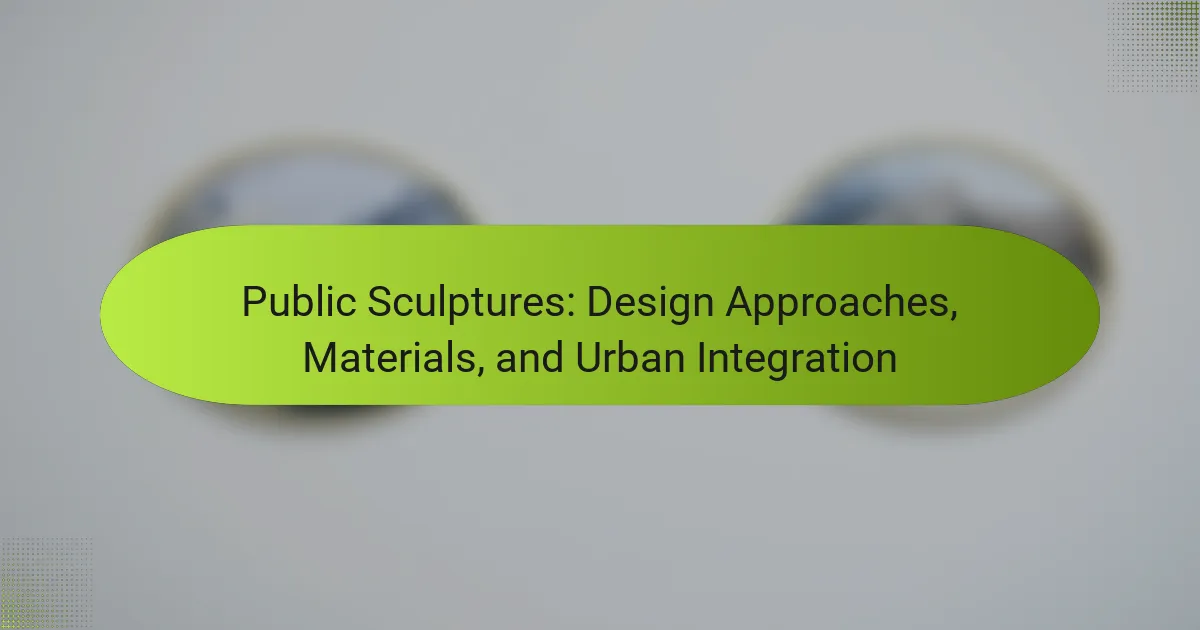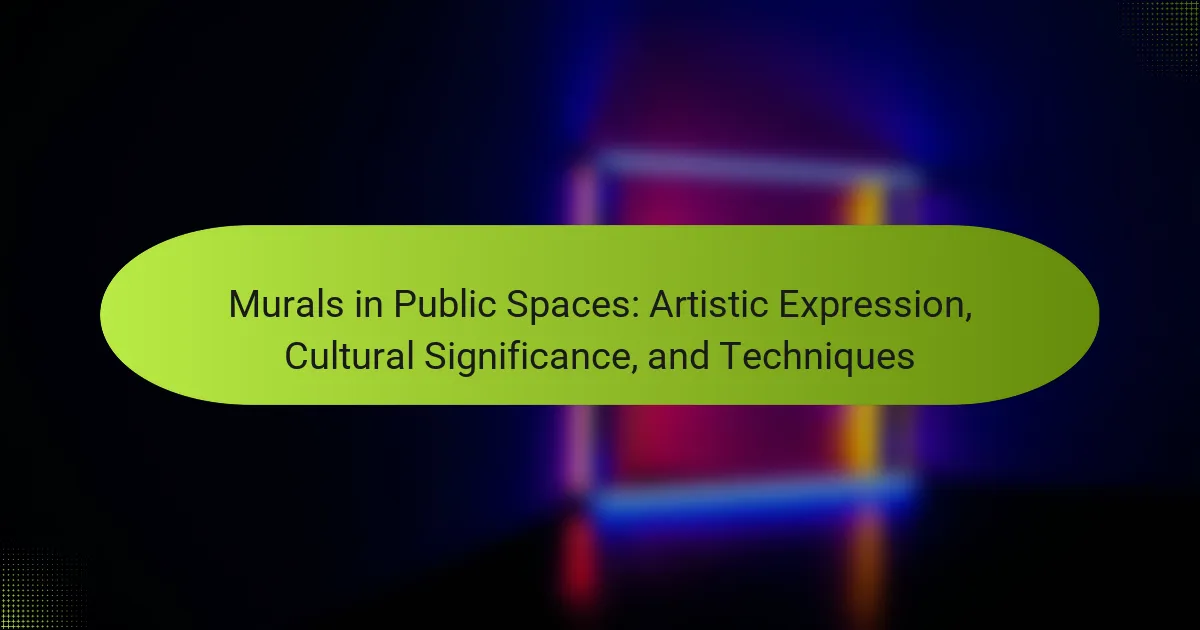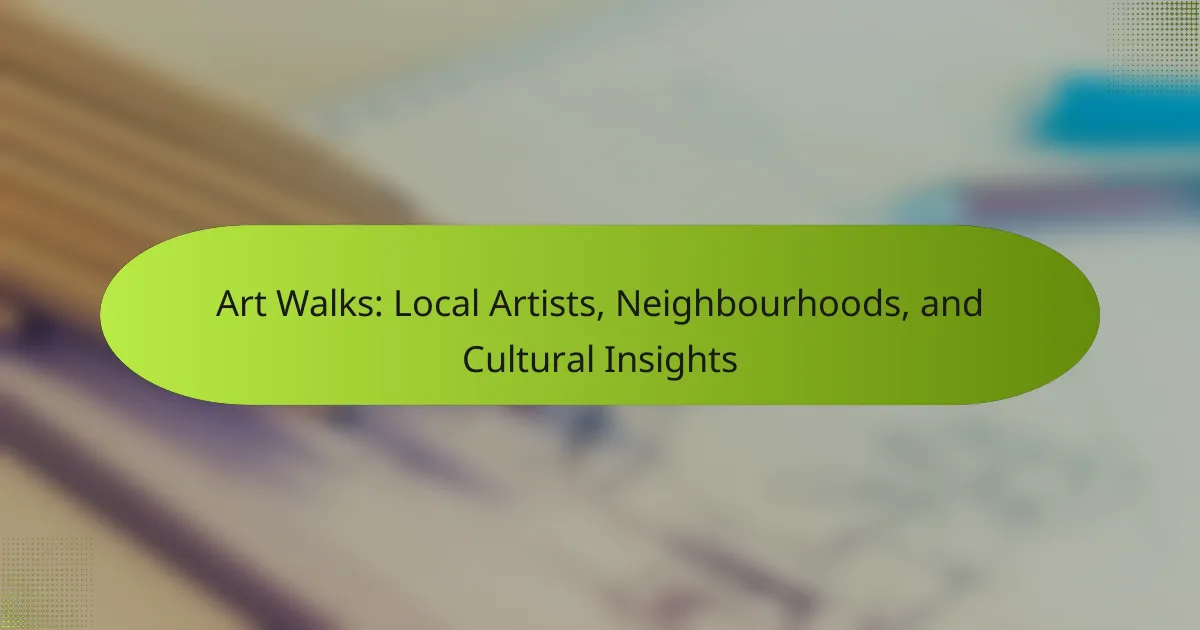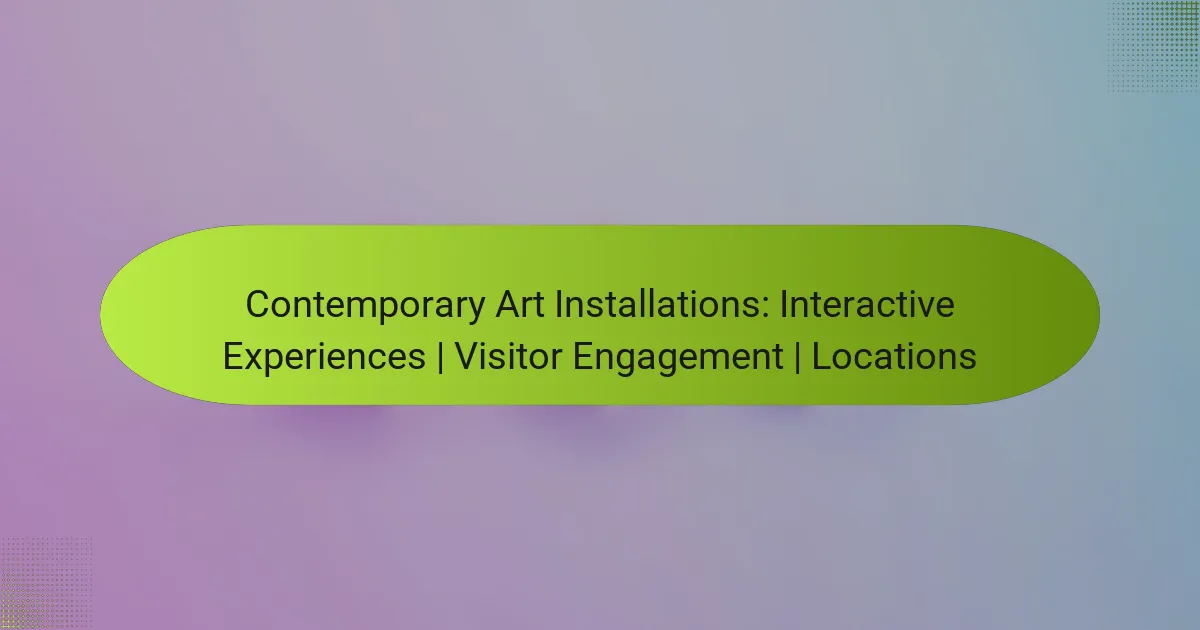Street art festivals enhance community engagement by promoting local talent and fostering collaboration. Key locations include Berlin, Melbourne, and New York City, each showcasing unique artistic styles. These events stimulate local economies and create opportunities for artists while addressing challenges like funding and regulations. Future trends focus on sustainability and digital integration to further engage communities.
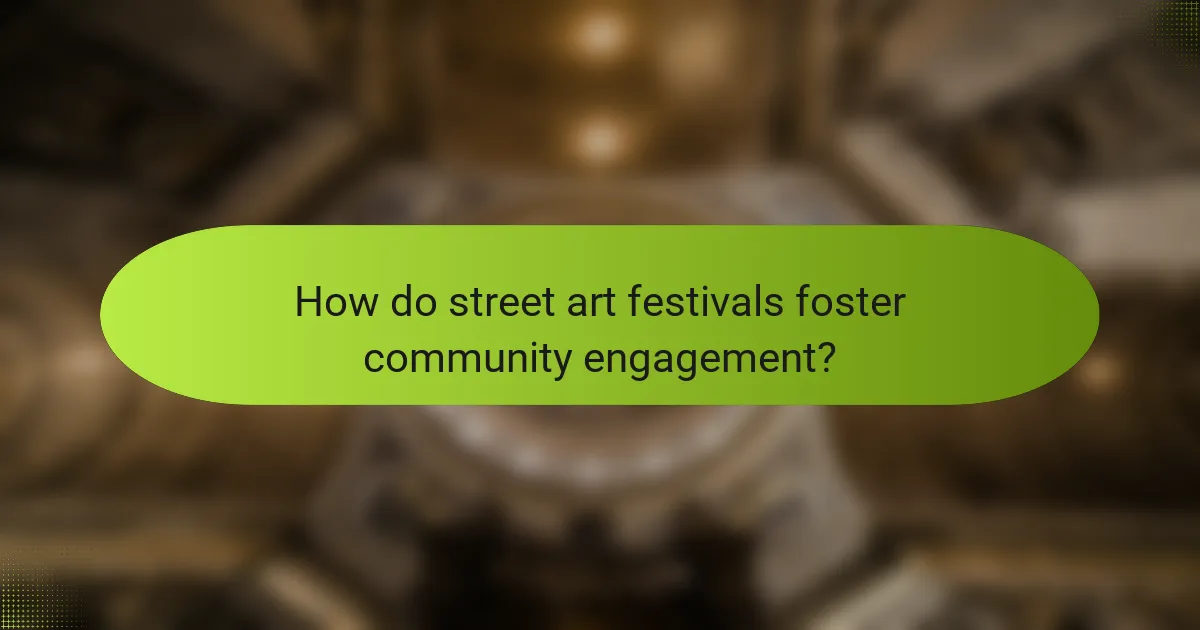
How do street art festivals foster community engagement?
Street art festivals foster community engagement by creating shared experiences, promoting local talent, and encouraging collaboration. These events bring diverse groups together, enhancing social bonds and fostering a sense of belonging. Artists often collaborate with community members, resulting in unique artworks that reflect local culture and identity. Additionally, street art festivals can stimulate local economies by attracting visitors and supporting local businesses.
What roles do local artists play in community involvement?
Local artists enhance community involvement through street art festivals by fostering creativity, collaboration, and cultural expression. They engage residents, attract visitors, and promote local identity. These festivals often serve as platforms for artists to showcase their work, while also encouraging community participation in the creative process. As a result, local artists play a crucial role in building social ties and revitalizing public spaces.
How do street art festivals promote cultural exchange?
Street art festivals foster cultural exchange by bringing together diverse artists and communities. These events showcase local and international talent, allowing for collaboration and dialogue. Artists often share techniques and styles, enriching the local art scene. Additionally, festivals attract visitors, promoting tourism and cultural appreciation. The unique attributes of each festival, such as themes or locations, can highlight specific cultural narratives, creating deeper connections among participants.
Which community initiatives are often associated with street art festivals?
Street art festivals often engage communities through initiatives like mural projects, workshops, and cultural exchanges. These activities foster collaboration between artists and local residents, enhancing community identity and pride. Festivals may also include educational programs that promote art appreciation and encourage youth participation. Community-driven events, such as clean-up days and local markets, further strengthen ties and support local economies.
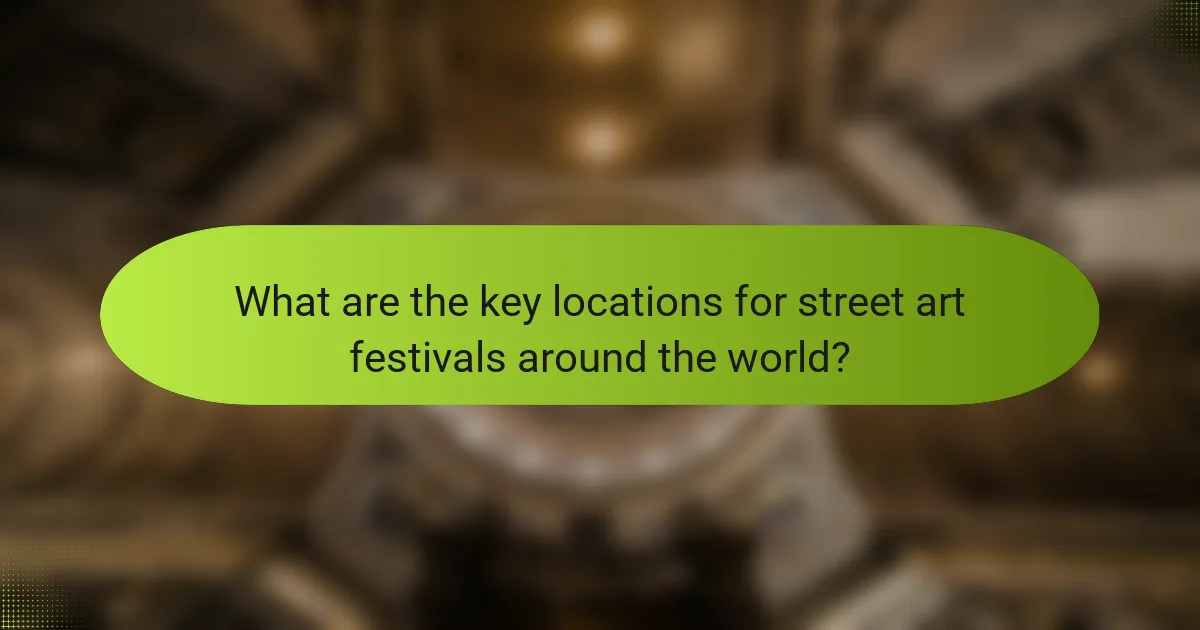
What are the key locations for street art festivals around the world?
Key locations for street art festivals include Berlin, Melbourne, New York City, Bristol, Buenos Aires, and Paris. These cities host vibrant festivals that showcase local and international artists, fostering community engagement and cultural exchange. Berlin’s Urban Nation is renowned for its innovative projects. Melbourne’s annual Melbourne Street Art Festival attracts thousands, highlighting its unique urban art scene. New York City features events like the Bushwick Collective, celebrating diverse styles. Bristol’s Upfest is Europe’s largest street art festival, emphasizing local talent. Buenos Aires hosts the Buenos Aires Street Art Festival, promoting artistic expression. Paris, with its rich art history, hosts various events that celebrate street art culture.
How do urban environments influence the choice of festival locations?
Urban environments significantly influence festival locations by providing diverse spaces for creativity and community interaction. Factors such as accessibility, local culture, and infrastructure shape these choices.
Street art festivals thrive in urban areas due to their vibrant atmosphere and existing art scenes. Cities offer a rich backdrop, attracting artists and audiences alike. The presence of public spaces, such as parks and streets, facilitates engagement with the community, enhancing the festival experience.
Additionally, urban environments often have established networks of local businesses and sponsors that support these events. This collaboration fosters a sense of ownership and pride among residents, encouraging participation.
In summary, urban settings create ideal conditions for street art festivals, driving artist participation and community involvement through accessible locations and cultural relevance.
Which cities are renowned for their annual street art festivals?
Cities renowned for their annual street art festivals include Berlin, Melbourne, Bristol, New York City, and Santiago. These cities attract international artists and foster community engagement through vibrant public art displays. Berlin’s festival highlights unique urban landscapes, while Melbourne is known for its diverse artistic styles. Bristol hosts the famous Upfest, showcasing local talent. New York City features the renowned Bushwick Collective, and Santiago’s festival celebrates cultural heritage through street art. Each city offers a distinctive atmosphere that enhances the street art experience.
What geographical trends can be observed in street art festival locations?
Street art festivals are increasingly located in urban areas with vibrant arts communities. Major cities like Berlin, London, and Melbourne host these events, showcasing diverse artists and fostering local engagement. Trends indicate a rise in festivals in smaller cities, promoting cultural tourism and community involvement. Regions with historical significance or artistic heritage attract more festivals, enhancing their appeal.
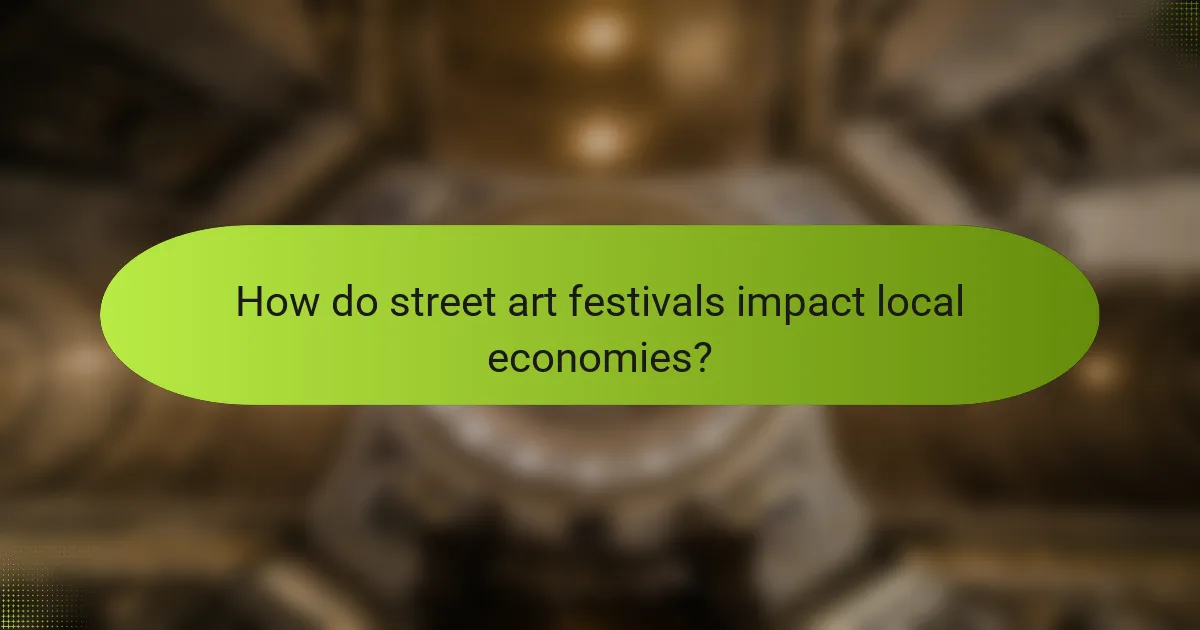
How do street art festivals impact local economies?
Street art festivals significantly boost local economies by attracting tourism, increasing sales for local businesses, and creating job opportunities. These events foster community engagement, often leading to long-term revitalization of neighborhoods. For example, cities hosting street art festivals report increased foot traffic and higher revenue for restaurants and shops. Additionally, local artists gain visibility and income through commissions and sales. Overall, the economic impact of street art festivals extends beyond the immediate event, contributing to sustainable growth in the community.
What financial benefits do street art festivals bring to host cities?
Street art festivals bring significant financial benefits to host cities through increased tourism, local business revenue, and job creation. These events attract visitors who spend on accommodations, dining, and shopping, boosting the local economy.
For example, a study found that street art festivals can increase local business revenue by up to 30% during the event period. Additionally, these festivals often create temporary jobs in event management, security, and hospitality, contributing to the local workforce.
Moreover, street art festivals can enhance property values in surrounding areas, as vibrant art scenes attract more residents and investors. Cities that host these festivals often see long-term economic growth as a result of improved community engagement and cultural tourism.
How do festivals support local businesses and tourism?
Street art festivals significantly boost local businesses and tourism by attracting visitors and fostering community engagement. They create vibrant environments that encourage spending in nearby shops and restaurants.
Artists participating in these festivals often showcase unique styles, drawing in art enthusiasts and tourists. For example, cities like Melbourne and Berlin have seen increased foot traffic and local revenue during such events.
Moreover, these festivals enhance community pride and cultural identity, making locations more appealing. As a result, local businesses benefit from heightened visibility and increased sales during the festival period.
In conclusion, street art festivals serve as a catalyst for economic growth and community cohesion, benefiting both local enterprises and tourism.

What unique artistic styles are showcased at street art festivals?
Street art festivals showcase unique artistic styles such as graffiti, muralism, stencil art, and street installations. These styles reflect local culture and engage communities in creative expression. Festivals often feature renowned artists and emerging talents, enhancing the diversity of artistic representation. Additionally, some festivals incorporate interactive art forms, allowing audience participation, which fosters a deeper connection between artists and viewers.
Which innovative techniques are often featured in street art?
Innovative techniques in street art include 3D murals, augmented reality, and interactive installations. These methods enhance viewer engagement and transform public spaces. Artists often use mixed media, combining traditional spray paint with digital elements. Community participation is encouraged through workshops and collaborative projects, fostering a sense of ownership and connection.
How do cultural influences shape the artistic expressions at festivals?
Cultural influences significantly shape artistic expressions at street art festivals by reflecting local traditions and community values. Artists often draw inspiration from historical narratives, social issues, and cultural symbols, creating works that resonate with festival-goers.
For example, in cities with rich cultural heritages, street art may incorporate traditional motifs and colors, enhancing the local identity. Festivals serve as platforms for artists to engage with communities, fostering dialogue and collaboration. This interaction can lead to unique artistic styles that emerge from the fusion of diverse cultural perspectives.
Moreover, street art festivals often highlight specific cultural themes, allowing artists to address contemporary issues such as social justice or environmental concerns. This dynamic exchange between culture and art enriches the festival experience, making it a vibrant celebration of community identity and creativity.
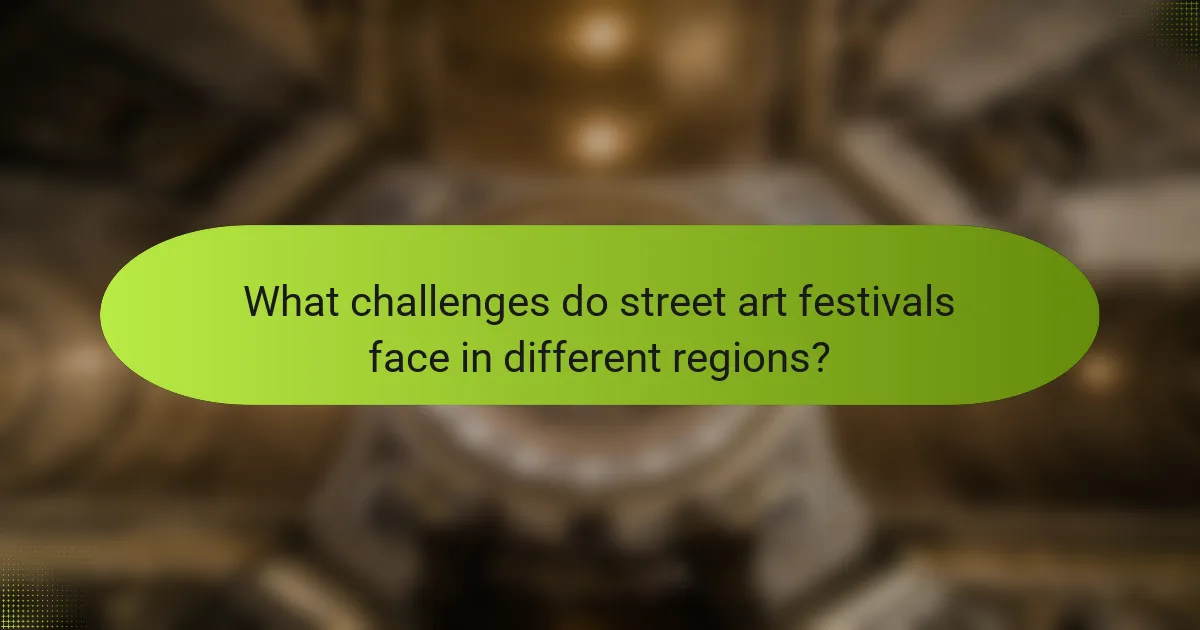
What challenges do street art festivals face in different regions?
Street art festivals face various challenges that differ by region, including funding, local regulations, and community acceptance. In urban areas, securing financial support is often difficult, leading to limited resources for artists and organizers. Additionally, strict regulations can hinder creative expression, as local authorities may impose restrictions on the types of art allowed. Community engagement varies widely; some regions embrace street art as a cultural asset, while others view it as vandalism. These factors significantly impact the success and sustainability of street art festivals across different locations.
How do legal regulations affect street art festivals?
Legal regulations significantly shape street art festivals by influencing artist participation and the types of art displayed. Regulations can dictate permitted locations, require permits, and establish guidelines for content. For instance, some cities may restrict themes to ensure community standards are met. As a result, festivals often adapt their programming to comply with local laws, which can enhance community engagement by aligning with public interests. Additionally, legal frameworks can provide protections for artists, fostering a more vibrant creative environment.
What are the common logistical issues faced by festival organizers?
Festival organizers commonly face logistical issues such as site selection, artist coordination, and community engagement. These challenges can impact the festival’s success and overall experience.
Site selection involves finding appropriate locations that accommodate large crowds and provide necessary amenities. Artist coordination includes managing schedules, contracts, and ensuring that artists have the resources they need. Community engagement is crucial for building local support and attendance, which can be hindered by miscommunication or lack of outreach.
Additionally, transportation logistics, security measures, and weather contingencies are vital considerations. Effective planning in these areas can mitigate potential disruptions and enhance the festival experience for attendees and participants alike.
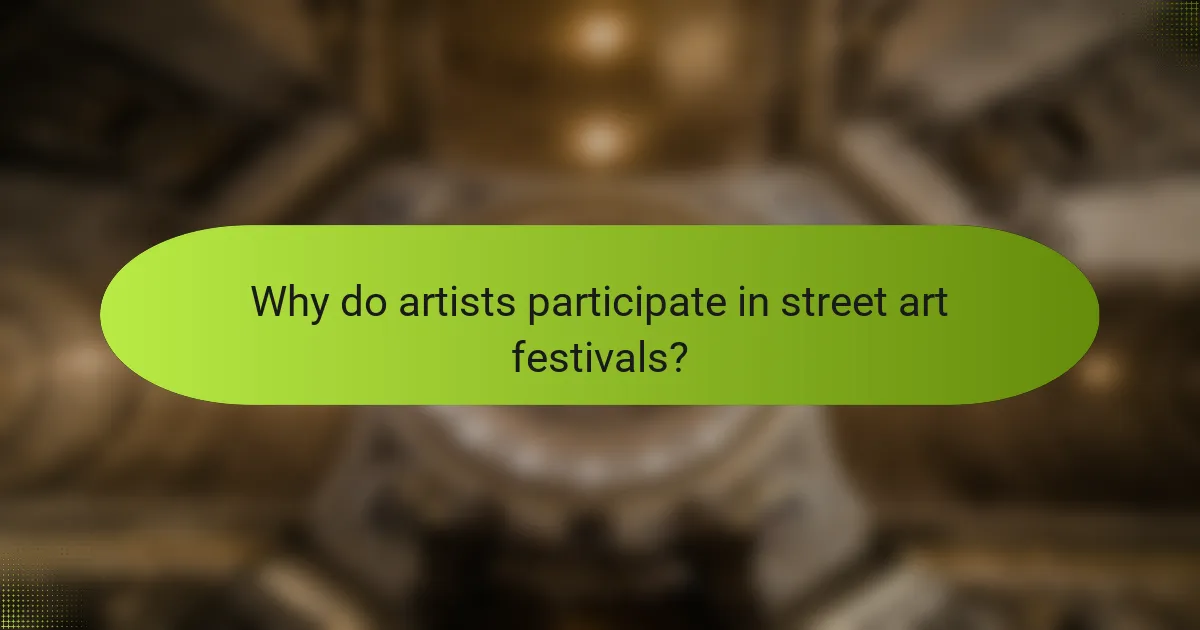
Why do artists participate in street art festivals?
Artists participate in street art festivals to gain exposure, connect with communities, and express their creativity. These events foster collaboration and allow artists to showcase their work in vibrant public spaces. Street art festivals often attract diverse audiences, enhancing community engagement and appreciation for art. Additionally, artists can network with peers and industry professionals, which can lead to future opportunities. The unique environment of street art festivals encourages innovation and experimentation, making them appealing to many artists.
What opportunities for exposure do festivals provide to artists?
Festivals provide artists with significant exposure opportunities through audience engagement, networking, and media coverage. Artists can showcase their work to diverse audiences, enhancing visibility and potential sales. Networking at festivals fosters collaborations and connections within the art community. Additionally, media coverage can amplify an artist’s reach beyond the event, attracting new followers and clients.
How do artists benefit from networking at these events?
Artists benefit from networking at street art festivals by gaining exposure, collaboration opportunities, and community support. These events allow artists to showcase their work, connecting them with potential clients, sponsors, and fellow creatives. Additionally, networking fosters a sense of community, encouraging artists to share resources and knowledge. As a result, artists can enhance their visibility and strengthen their professional relationships.
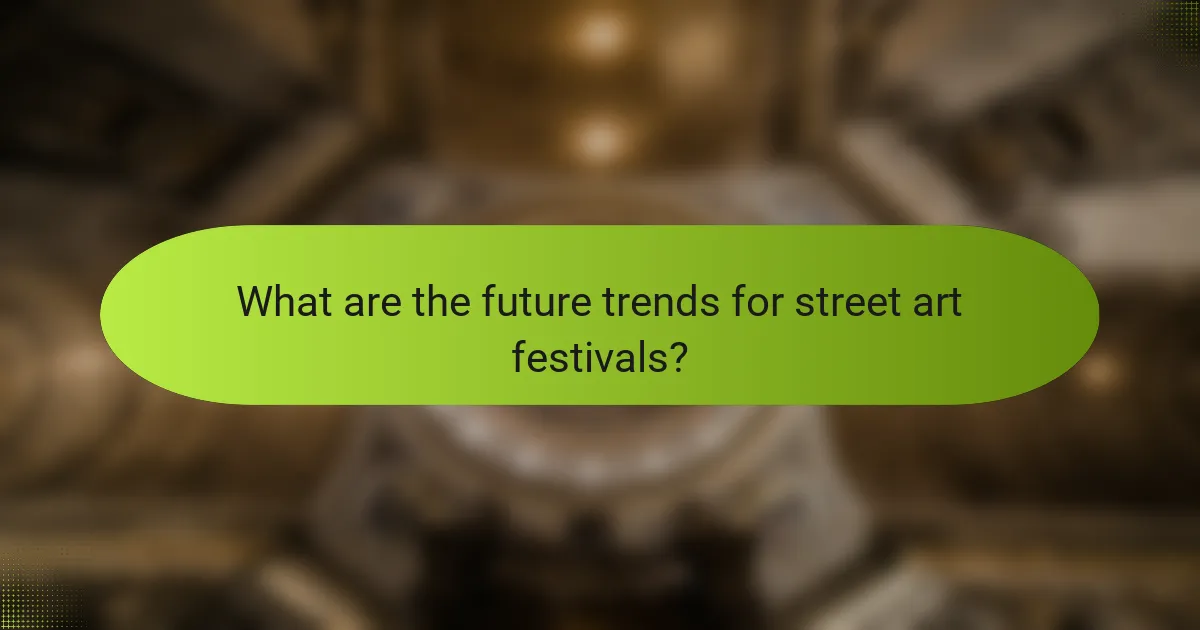
What are the future trends for street art festivals?
Street art festivals are increasingly focusing on sustainability, digital integration, and community involvement. Future trends include eco-friendly practices, augmented reality experiences, and collaborations with local artists to enhance cultural representation. These developments aim to create more engaging and inclusive environments for attendees. Additionally, festivals are likely to leverage social media for broader outreach and participation.
How is technology influencing the evolution of street art festivals?
Technology is transforming street art festivals by enhancing artist visibility and audience interaction. Digital platforms allow artists to showcase their work globally, reaching wider audiences. Augmented reality features enable viewers to engage with art in innovative ways, creating immersive experiences. Social media amplifies festival promotion, fostering community engagement and participation. Additionally, technology facilitates collaboration among artists, leading to unique and diverse artistic expressions.
What role does social media play in promoting street art festivals?
Social media significantly enhances the visibility and engagement of street art festivals. It serves as a platform for artists to showcase their work, connect with audiences, and foster community involvement.
Through social media, festivals can share real-time updates, promote artist lineups, and highlight interactive activities. This engagement helps attract diverse audiences, increasing attendance and participation.
Moreover, user-generated content on social media amplifies festival reach. Attendees sharing their experiences can create a buzz, encouraging others to join future events.
Overall, social media acts as a vital tool for promoting street art festivals, enhancing community spirit and artistic appreciation.
What best practices can organizers adopt for successful street art festivals?
Organizers can adopt several best practices to ensure successful street art festivals. Engaging the community fosters local support and participation. Collaborating with artists enhances creativity and diversity. Selecting accessible venues increases attendance and visibility. Promoting the event through social media and local partnerships boosts awareness and engagement. Lastly, incorporating interactive elements encourages audience involvement and connection to the art.
